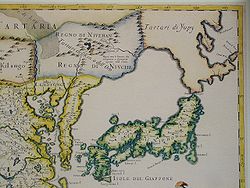- Maarten Gerritsz Vries
-
 Cape of Aniva, Cape of Patience, Staten Island (Isola di Stati), and Strait of de Vries all seen on this Italian map from 1682. As the map shows, de Vries did not have a chance to discover either La Pérouse Strait or the Strait of Tartary, the mapmakers thus making Hokkaido and Sakhalin part of the mainland
Cape of Aniva, Cape of Patience, Staten Island (Isola di Stati), and Strait of de Vries all seen on this Italian map from 1682. As the map shows, de Vries did not have a chance to discover either La Pérouse Strait or the Strait of Tartary, the mapmakers thus making Hokkaido and Sakhalin part of the mainland
Maarten Gerritsz Vries, or Fries, also referred to as de Vries, (18 February 1589, Harlingen - late 1647, at sea near Manila) was a 17th-century Dutch cartographer and explorer, the first Western European to leave an account of his visit to the Sea of Okhotsk and the island of Sakhalin.
Not much is known about the life of de Vries. He was probably born in Harlingen, Netherlands, in 1589 and spend many years in Taiwan.[1] He is best remembered for his 1643 expedition to the north-western Pacific Ocean to discover the coast of Tartaria, on account of Anthony van Diemen, the governor in Batavia. This was the second expedition to look for legendary gold and silver islands in the Pacific, which nobody had discovered, after a failed expedition in 1639 under command of Matthijs Quast.
Contents
De Vries expedition
The two ships, the Castricum under De Vries and the Breskens under Hendrick Cornelisz Schaep left Batavia, the capital of Dutch Java, in February 1643. After a stop in Ternate in the Moluccas they continued their journey on April 4. On May 20 the two ships lost touch with each other in a storm, while off Hachijo Shima, an island some 290 km south of Tokyo, which, due to this setback, was christened Ongeluckich, or "Unlucky", Island by the Dutch.
Breskens in Yamada
The Breskens arrived in a promising bay and was received friendly by the population of Yamada on Honshu.[2] Six weeks later the Breskens again sailed to Yamada, probably while they had a good time. In the evening they organized a party with a samurai and most probably some Japanese women. (It is not known what exactly happened, because the diary got lost in 1692, after Nicolaes Witsen received it.) The next day, July 29, ten members of the crew, including the captain were invited by the women to come to a farm where they would receive fresh vegetables and fish. The unarmed crew was offered sake and rice, but captured, and sent to Morioka and Edo for interrogation. The Japanese feared Spanish Jesuits had come to land. As a result, bakufu officials were extremely anxious about the problem of coastal defenses. However after it was understood that the crew were Dutch and not Catholics, the problem to be solved became one of deciding by which procedure the Dutch should be released.[3] After Jan van Elserac had arrived the shogun Tokugawa Iemitsu sent them in December to Deshima. The crew had to wait nine months for the next ship to Taiwan while the Breskens had left Honshu already at the end of July (without a captain) searching for the Gold and Silver Islands.
Castricum going north
In the summer of 1643, the Castricum sailed by the southern Kuril Islands, visiting Kunashir, Iturup (which they named "Staten Island", although nowadays this name is only used to refer to Staten Island, in New York City), and Urup, where they met with the Ainus again, and which they named "Company Island" and claimed for the Netherlands.
The Castricum passed between the islands of Iturup and Urup, the strait between the islands being later named Vries Strait after its discoverer, and entered the Sea of Okhotsk.
The Dutch sailed north, without encountering any land, until being driven south-west toward the northern shores of Hokkaido. Then they sailed north again, discovering Cape Aniva (the southeastern tip of Sakhalin Island), Gulf of Patience (where they indeed had to be patient, waiting for the fog to clear), and Cape Patience east of it.
After another excursion, now east into the Pacific, the Castricum returned to Japanese waters and managed to meet with the Breskens off Kyushu. The two ships sailed to Fort Zeelandia (Taiwan) and returned to Batavia in mid-December 1643.
Maarten Gerritsz Vries died on board from disease after leading an unsuccessful attempt to invade the Philippines.
Sources
External links
- Spate, Oskar Hermann Khristian (1983). Monopolists and Freebooters. Taylor & Francis. pp. 40–41. ISBN 0709923716. http://books.google.com.au/books?id=594OAAAAQAAJ.
Categories:- 1589 births
- 1646 deaths
- Dutch explorers
- 17th-century explorers
- Explorers of the Pacific
- History of the Netherlands
- Sakhalin
- Kuril Islands
- Dutch East India Company
- People from Friesland
Wikimedia Foundation. 2010.

